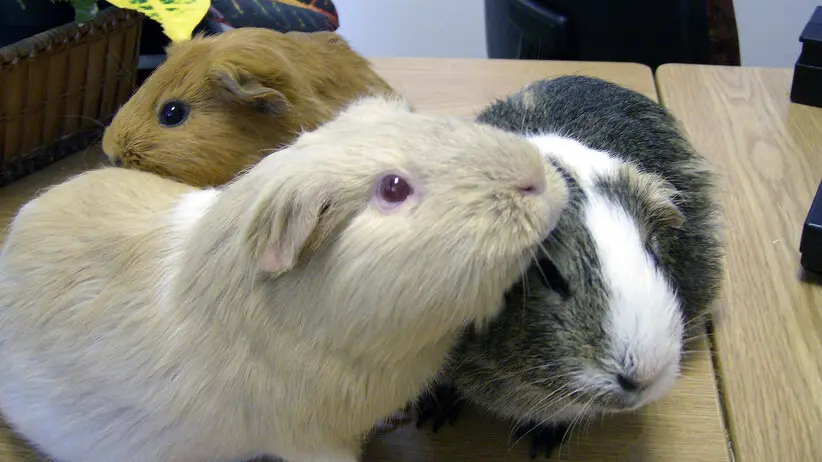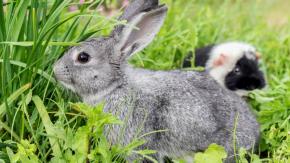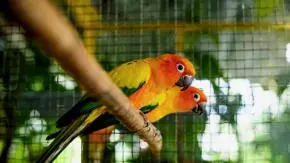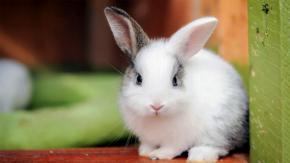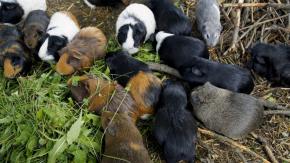Guinea pigs and hamsters are distant cousins who belong to the Rodentia order. Guinea pigs belong to the Caviidae family, whereas hamsters belong to the Cricetidae.
Guinea pigs are larger and heavier than hamsters, weighing about 2-4 times as much as hamsters. Guinea pigs may weigh anywhere from 1.5 to 2.6 pounds, whereas hamsters only weigh 1 to 10 ounces.
As a reason, guinea pigs will demand a considerably larger environment with more amenities—Guinea Pig Cage Size.
According to the Humane Society, one to two guinea pigs require a minimum of 7.5 square feet of living area and a recommended space of 10.5 square feet.
Guinea pigs require larger enclosures to exercise on their own time and enjoy some privacy. Most pet store cages are far less than the minimum size requirement.
For the very first few weeks, when guinea pigs are still infants, they may be okay. However, when the guinea pigs grow, the owner would need to consider extending the cage.
Here are a few cage alternatives suitable for guinea pigs, or go to Different kinds of Enclosures to learn more about different cage types.
C&C Cage is a Company That Makes Cages
The Classic C&C Cage
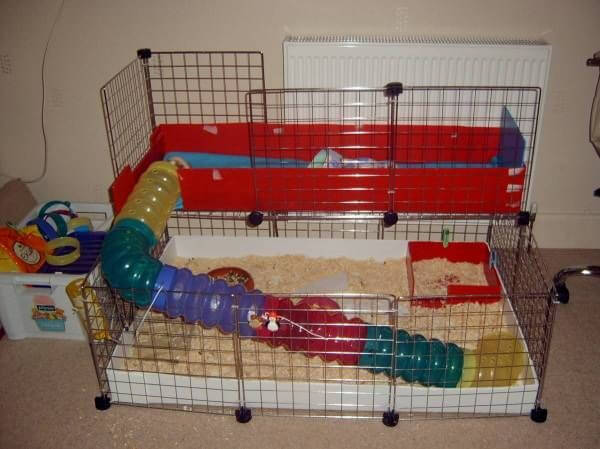
This is one of the most popular Alternative solutions among guinea pig lovers, professionals, and enthusiasts. The C&C cage comprises two major parts: C&C grids (which serve as walls) and coroplast (used as a waterproof base).
Even though a C&C cage necessitates some construction, Building it, on the other hand, does not need a lot of time or expertise. The 2 x 3 grid size would offer a minimum of 7.5 square feet for your guinea pigs (sample dimension), while the 2 x 4 grid size could provide a suggested height of 10.5 square feet.
Pre-Built Cage
More than 90% of pre-built cages labelled “designed for guinea pigs” are unsuitable for the animals. The majority of them do not even meet the bare minimum of 7.5 square feet, let alone the suggested 10.5 square feet.
The Midwest Guinea Habitat is one brand that is ideal for a pair of guinea pigs. Many experts, however, advise upgrading to the C&C cage or DIY alternatives.
Hamster Cage Size
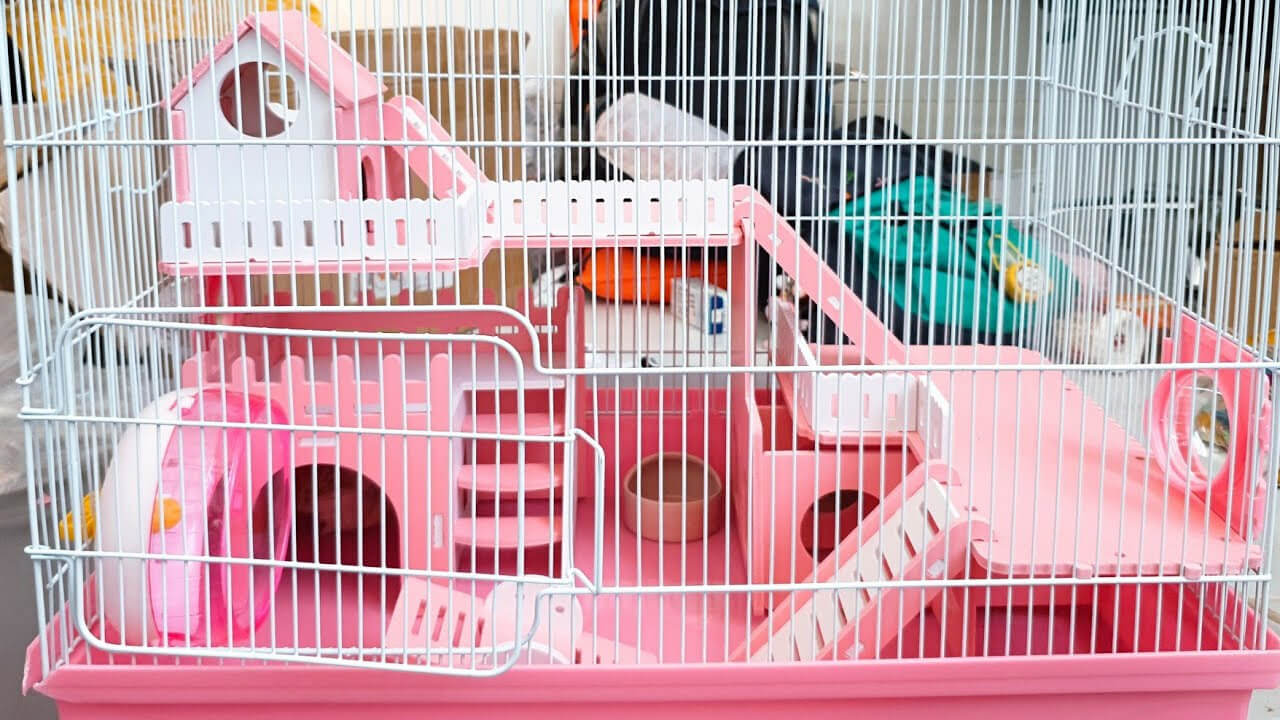
According to the Humane Society of the United States, hamsters need at least 2 to 3 square feet of room per hamster. Unlike guinea pigs, hamsters are more solitary and should be maintained alone.
Although hamsters require less space than guinea pigs, they thrive in a more significant, more spacious habitat. Studies show a favourable relationship between the size of the cage and the lifetime of a hamster (they live longer and happier in a larger cage!).
Cages that are pre-built and cages that you build yourself
There are some excellent pre-built choices for hamsters, but the similarity with tiny animals is that the cages designed for hamsters are, more often than not, smaller than they should be
Guinea Pig Behaviour
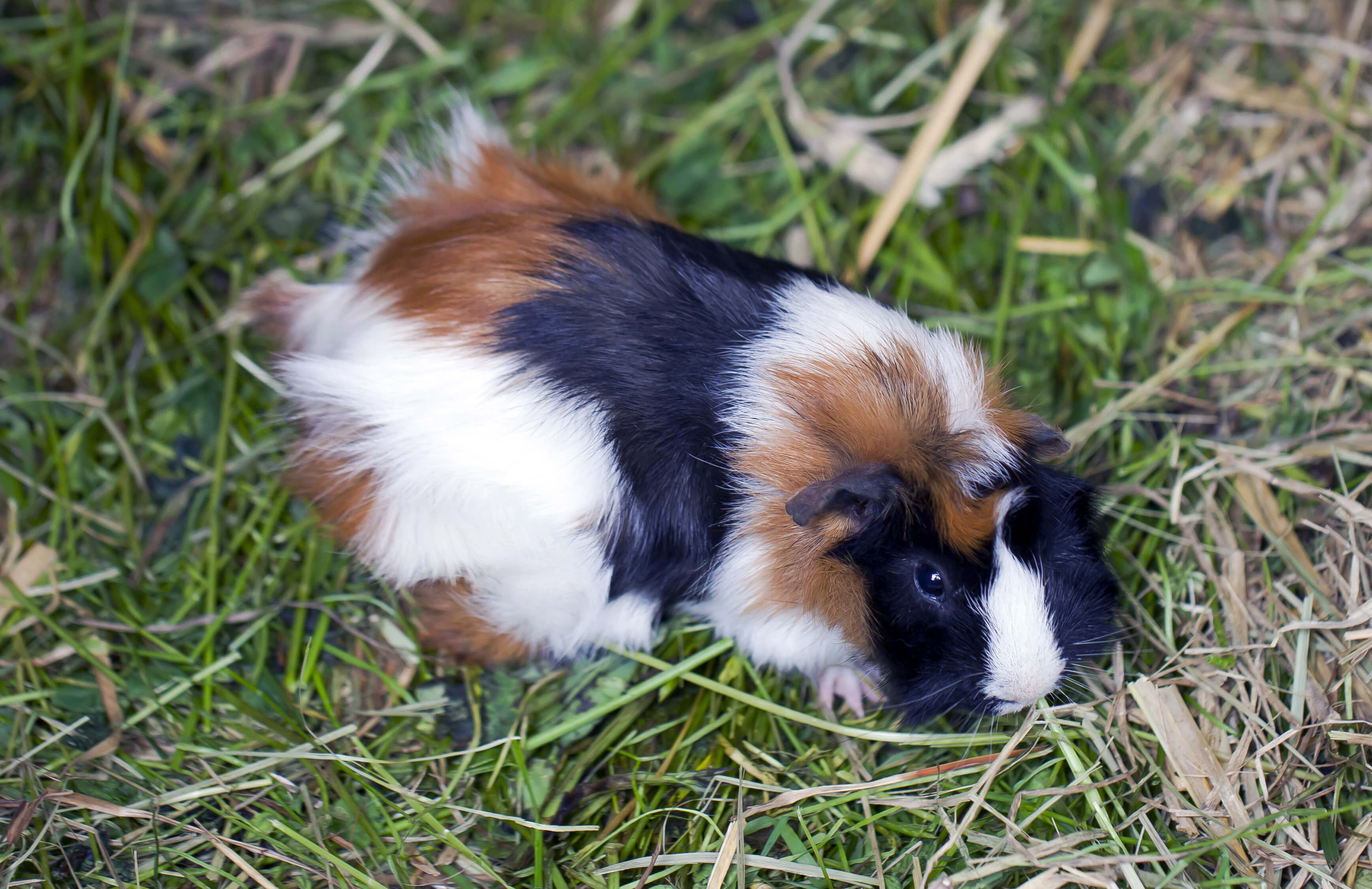
Guinea pigs are sociable creatures who are exceedingly affectionate; thus, biting is quite unusual. They have a calm and kind demeanour. As soon as your guinea pigs are accustomed to their environment and comfortable with social interactions, you can hug them.
Guinea pigs must be handled with both hands supporting their bottom and Belly, so they are longer than hamsters and have weak spines.
Guinea pigs enjoy floor time because it allows them to explore a greater area. During these periods, you’ll be able to see a lot of popcorning and zoomies.
To assist them in exploring the floor and protect their sensitive feet during their floor time, we recommend utilising a guinea pig fleece liner.
Voices Of Guinea Pigs
Guinea pigs are highly friendly and expressive, which results in various noises.
“Wheek”
They can whistle or call you “wheek” to welcome you home, express their happiness, or even demand that you feed them vegetables. The expressions of these different guinea pigs are sure to bring a smile to everyone who sees them.
“Purring”
Depending on the tone of the sound, it can have a variety of connotations. A deep comfortable purr indicates that the guinea pig is content, but a higher pitch purr indicates displeasure, and a shorter purr indicates fright.
“Chirping”
You may hear a strange noise that sounds like a bird chirping. The reason why guinea pigs produce this noise is unknown, but it may be heard when a guinea pig loses a partner.
Guinea Pig Life Expectancy
Guinea pigs have a lifetime of 5-7 years on average, with many lasting into their double digits! As you can see, if you want to adopt a guinea pig, you need to be prepared to make a long-term commitment.
A guinea pig’s lifetime is influenced by various factors, including food, health, and even breed. Many health problems, such as bumblefoot or enlarged teeth, can be addressed if caught early enough.
The usage of Fleece Liners may avoid Bumblefoot. Fleece liners’ have high absorption, which protects our guinea pigs from lingering in damp surroundings, a significant cause of bumblefoot.
Behaviour of Hamsters
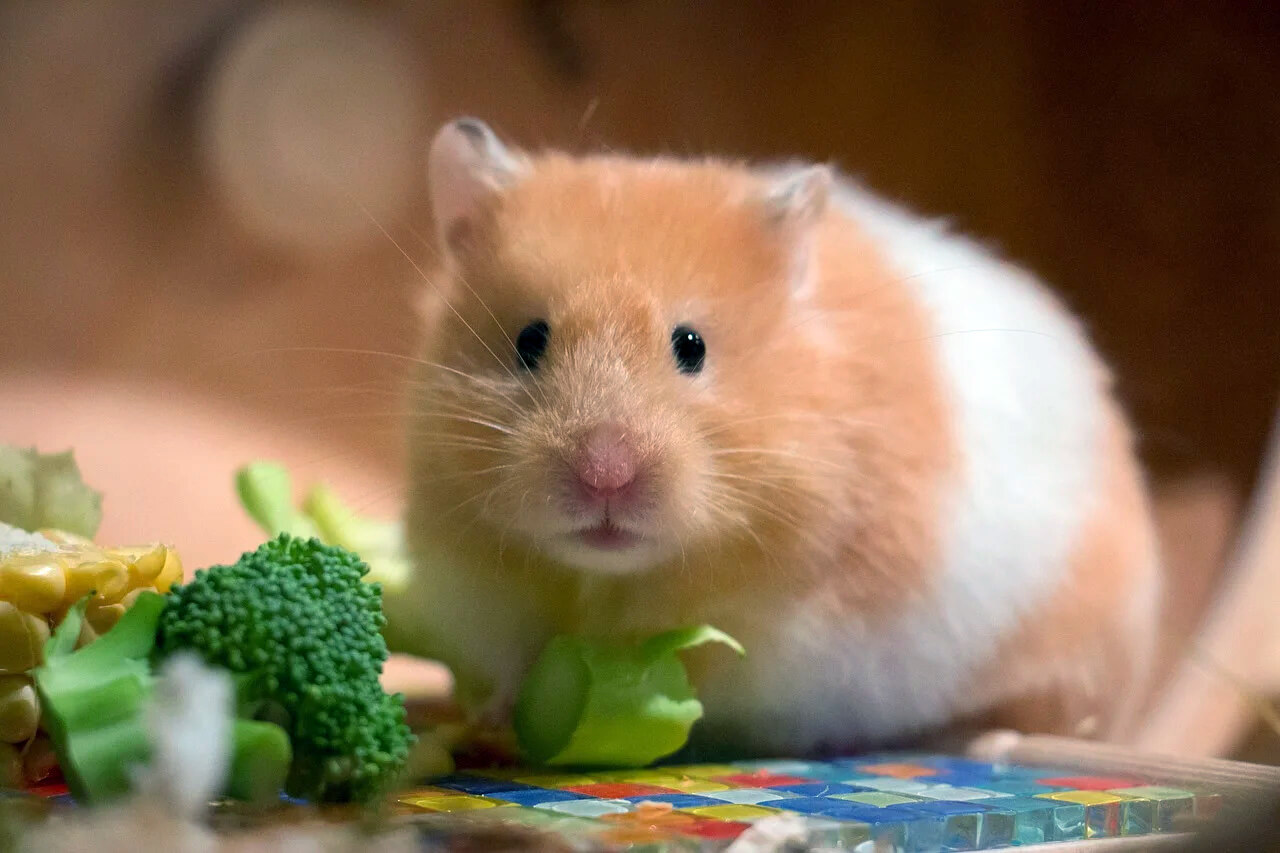
Compared to guinea pigs, hamsters are more isolated and silent. Hamsters can be friendly toward humans, but they can bite if they are not given enough time to earn their confidence.
They, like guinea pigs, require daily handling and interaction to become accustomed to you. Another feature that distinguishes hamsters from guinea pigs is that they are nocturnal, meaning they are more active in the evening, night, and early morning.
Vocalisation of Hamsters
Hamsters, like pigs, can vocalise to communicate anything they want. Here are among the most typical sounds connected in hamsters.
Squeaking and Squealing
When your hamster attempts to warn you of anything, you will hear these sounds. When they are first held or have been held too harshly, this may be the case.
Screaming
As the name implies, this is how your hamster expresses their terror.
Hissing
Hamsters can be aggressive at times, and this sound is connected with aggressive behaviour. When hamsters hiss, it’s typically a warning indication.
The Lifespan Of A Hamster
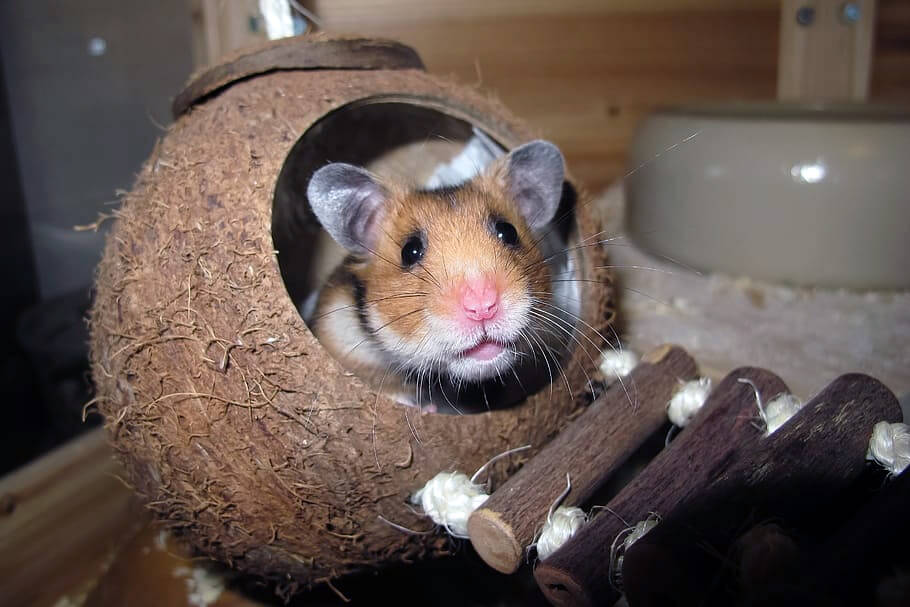
Hamsters live for 2 to 2.5 years, although their lifespan is influenced by various factors, including their species, genetics, nutrition, activity, lifestyle, and quality of care, as with guinea pigs.
Hamster parents can help ensure that their hamsters live a long and happy life by providing that their environment and diet are healthy and appropriate.
Guinea Pig Daily Activities
When compared to hamsters, Guinea Pigs consume more, which regrettably implies more “raisins.” Once or twice daily, the guinea pig cage should be spot cleaned (poop and hay on the floor should be removed with a brush or vacuum).
Guinea Pigs also have another companion hedgehog to connect with and thrive with human interaction. You must be willing to talk to them, spend time with them, and regularly give them enough floor time.
With A Hamster, Many Things Is To Be Done Daily
Similar actions are required in hamsters, although they do not require much floor time. Most hamster owners regularly let their pets out of their cages at least once a week.
Hamsters require daily interaction to become acclimated to your presence and avoid biting. It is suggested that hamsters’ food be changed every day, although, unlike guinea pigs, new food is not required every day.
In reality, supplying fresh food every other day is enough to complement their diet with a well-balanced meal.
Differences in Nutrition
Guinea Pigs and Hamsters Have Different Nutrition Needs
Nutrition For Guinea Pigs
Guinea pigs are herbivores and require a specific diet in terms of nutrients. Daily, they must be given an unlimited amount of hay and fresh water and 1 cup of fresh veggies (bell peppers, cucumbers, red leaf lettuce, and on and on).
Even though most pelleted foods have daily amounts of vitamin C, you can also feed your guinea pig fruits and vegetables to make the vitamin intake more natural. You will discover that feeding your pet can help you bond with them.
Alfalfa hay and Timothy hay are two popular types of hay. Because of alfalfa hay’s high vitamin C content, it’s the best choice for babies. Once they grow, you can consider shifting over to timothy hay, which is more fibrous. As guinea pigs gain adulthood, the higher fibre content becomes increasingly important for their health.
It is possible to prevent complications such as scurvy by providing Vitamin C to them.
Nutrition For Hamsters
Hamsters are omnivores, so foods they eat in the wild should be supplemented. It is recommended to feed hamsters at least 10 grams of dry hamster food a day and consist of at least 16 per cent protein and 5 per cent fat.
Interesting Facts
When it comes to hamsters and guinea pigs, there are many distinctions. Even though they are somehow related, they are like distant, distant cousins.
Guinea pigs and hamsters are both members of the Rodentia order; however, guinea pigs belong to the Cavia genus and hamsters to the Cricetinae genus.
SIZE and WEIGHT
Another significant difference is size. Guinea pigs are much larger than hamsters, as you might expect. A guinea pig weighs 1.5-2.6 pounds and is about the size of a large potato, but a hamster is about the size of a strawberry and only weighs 1-10 ounces.
TAILS, FEET, HANDS
Hamsters have two hands, two feet, and a tail, but guinea pigs have four feet and no tail. Guinea pigs spend much of their time on all fours and never utilise their front paws to grip objects like hamsters.
Hamsters are known for sitting up on their hind legs and chewing on seeds. Guinea pig feet are delicate; therefore, providing guinea pig fleece lining in their homes and where they play is a good idea.
ACTIVITY
Guinea pigs are more active throughout the day, although they only sleep for 4 hours overall. If you have a squeaky running wheel, you may not want to have a hamster in your room because they are more nocturnal.
OMNIVORE vs. HERBIVORE
Hamsters are omnivores, meaning they consume both plant and animal-based foods. You may feed mealworms to your hamsters, something not many new pet owners are aware of.
On the other hand, Guinea pigs are herbivores, which means they exclusively consume plants.
COMPANIONS
Guinea pigs are incredibly sociable and should be maintained with other guinea pigs. If you can’t have more than one, devote much attention to the guinea pig.
On the other hand, Hamsters should be left alone since they are highly territorial. Putting more than one of these in a cage may result in a fight.
REPRODUCTION
Guinea pigs produce puppies, with each litter including 2-4 pups. They have been found to take up to 13 pups at a once. Hamsters may have 6-12 pups on average, but up to 20 pups at the most!
Conclusion
We hope this information aids you in your decision to have guinea pigs or a hamster! We would strongly suggest guinea pigs to anyone prepared to commit to caring for them for the rest of their lives. However, it is entirely up to you, as each has its own set of advantages and disadvantages.
Based on what We’ve read, we’d say that caring for guinea pigs takes a little more effort and time than caring for hamsters, but it’s all worth it!

